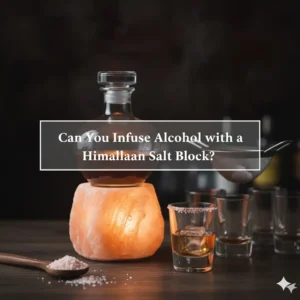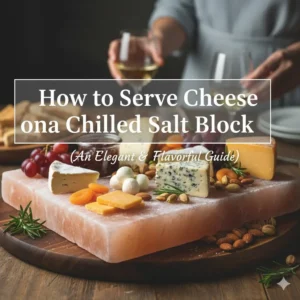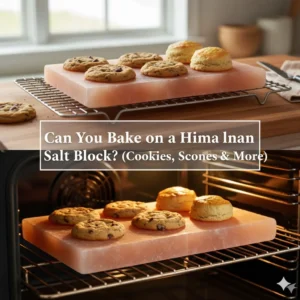Cooking a burger on a Himalayan salt block refines a casual meal into a culinary technique. This solid slab of ancient mineral salt conducts heat evenly, infusing the meat with a delicate, natural salinity while creating a uniform, caramelized crust. Unlike metal grills, it enhances depth of flavor without flare-ups or added oil. This guide explains how to preheat the block, shape and sear patties, and produce a perfectly balanced, restaurant-quality smash burger at home.
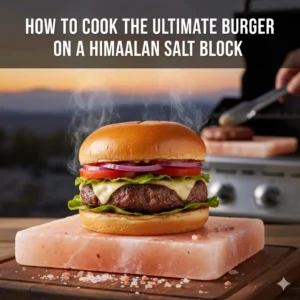
Prerequisites: Tools & Materials Needed
Before cooking your burger on a Himalayan salt block, assemble the essential tools and ingredients. Having the right setup streamlines the process and ensures you achieve an evenly seared, well-balanced smash burger. Each item supports efficient heating, safe handling, and natural seasoning throughout every stage of cooking.
| Item | Description / Notes |
|---|---|
| Himalayan Salt Block | Food-grade, ideally sourced from the Khewra Mine; approximately 8 × 8 × 2 inches. Its dense, mineral-rich surface provides stable heat and subtle natural salting. |
| Quality Ground Beef (80/20 grind) | Select fresh, chilled beef to maintain structure during searing and preserve juiciness in each patty. |
| Metal Tongs | Provide control and safety when flipping patties without damaging the salt block surface. |
| Oven or Grill | Should allow gradual heating up to roughly 450–500°F for proper block preheating and precise temperature control. |
| Thermometer (optional) | Confirms surface temperature for consistent searing and an evenly caramelized crust. |
| Burger Buns and Toppings | Prepare buns, cheese, and fresh vegetables in advance so assembly is seamless while patties rest. |
| Scraper and Soft Brush | Use for gentle cleaning after cooking to remove residue without water exposure or harsh detergent. |
Organizing these materials in advance ensures each stage—from preheating to final assembly—runs smoothly. Proper preparation protects your tools, extends the salt block’s life, and elevates the texture and flavor consistency of every burger you serve.
Step-by-Step Guide to Cooking the Ultimate Burger on a Himalayan Salt Block

Step 1: Gradually Heat the Himalayan Salt Block
To prevent cracking, heat the salt block gradually. Begin at 200°F for 15 minutes, then raise the temperature to 400°F for another 15 minutes, followed by 450–500°F for a final 15 minutes. This staged approach allows the block to adapt slowly and minimizes thermal stress.
Once the block reaches searing temperature, a drop of water should vaporize instantly. Use a surface thermometer to confirm that the heat is even across the block. At this point, it is ready to create the signature crust that defines a smash burger.
Step 2: Form High-Quality Burger Patties
Select fresh ground beef with an 80/20 blend for optimal balance between tenderness and moisture. Shape each patty to about three-quarters to one inch thick, applying only light pressure to preserve the meat’s natural texture. Overworking the beef leads to a denser consistency and less even crust development.
Avoid adding salt before cooking. The Himalayan salt block will season the meat naturally as it sears, imparting a clean mineral flavor that complements, rather than overpowers, the beef’s richness.
Step 3: Sear the Burgers on the Salt Block
When the block is fully heated, place the patties directly onto its surface. A distinct sizzle indicates the correct temperature. Cook each burger undisturbed for three to four minutes to develop a uniform golden-brown crust. This continuous sear differentiates salt block cooking from traditional grilling.
Flip the patties with metal tongs and cook the other side for two to three minutes or until desired doneness. Add cheese, if desired, during the final 30 seconds to allow gentle melting without scorching. Expect a juicy, caramelized burger with subtle mineral notes throughout.
Step 4: Serve and Enjoy Your Mineral-Seasoned Burger
Remove the patties promptly once cooked to preserve their juiciness and texture. The salt surface provides refined seasoning without the sharpness associated with table salt, producing a well-balanced and savory crust.
Assemble the burgers on toasted buns, add your chosen toppings, and serve immediately. The combination of mineral-rich sear and natural seasoning transforms a familiar dish into a chef-level experience prepared at home.
Watch the cooking process here
Premium Himalayan Salt Blocks for Culinary and Hospitality
Partner with Jilin Ever Creation to source natural, food-grade Himalayan salt blocks from Pakistan’s Khewra Mine. Our customizable blocks enhance flavor, improve searing results, and elevate presentation for restaurants, retailers, and hospitality brands. Each unit meets international food safety standards and supports flexible bulk orders tailored to diverse operational needs.
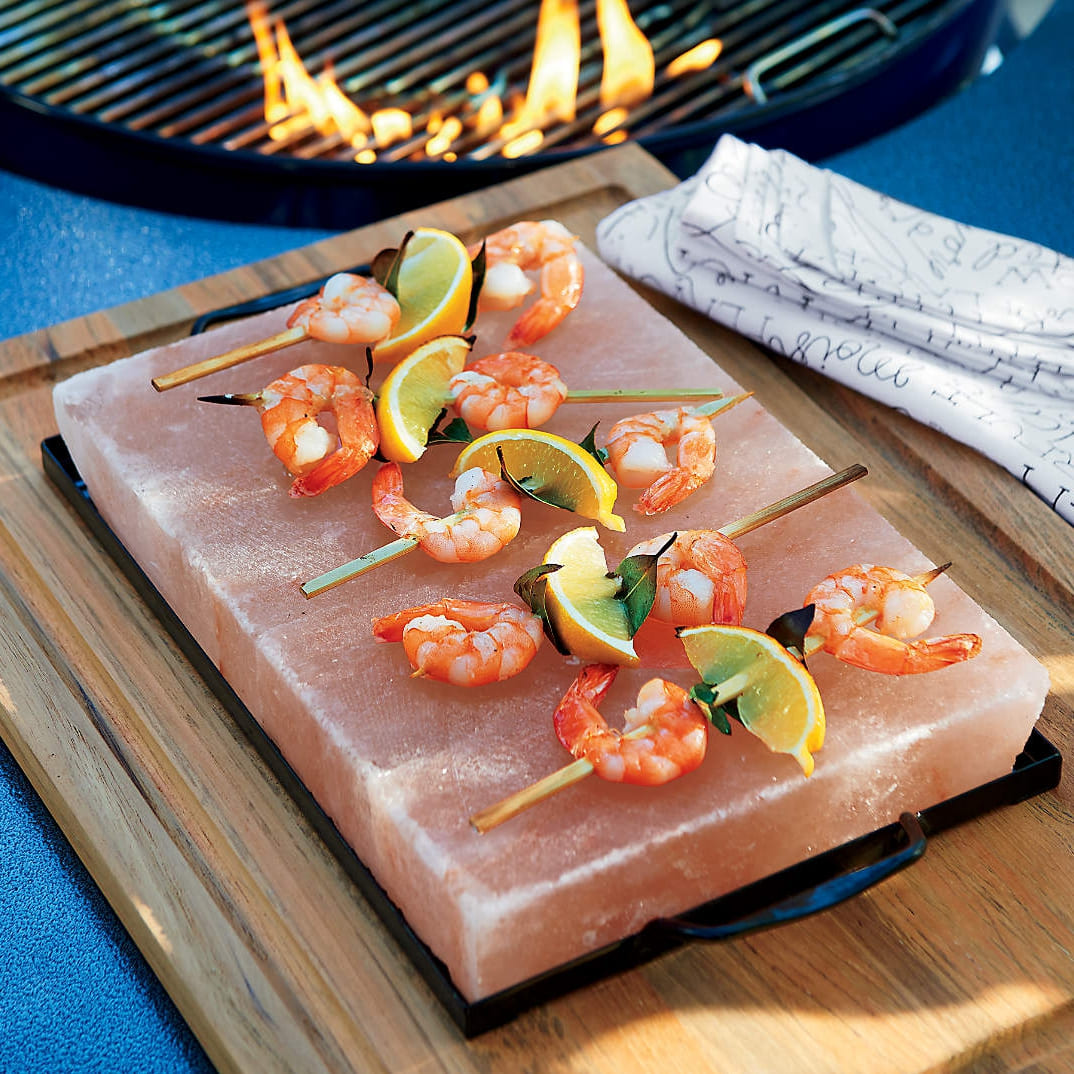
How Himalayan Salt Blocks Enhance Burger Flavor and Texture
Cooking burgers on a Himalayan salt block elevates a classic method into a refined technique. The block’s dense, mineral-rich surface heats evenly and retains a dry, stable temperature, creating an ideal searing environment that develops a uniform, golden-brown crust across each patty. This consistent heat is what transforms a standard burger into a true smash-style experience.
Unlike metal pans or grill grates, the salt block imparts balanced seasoning as the meat cooks. Its minerals infuse flavor gradually, enhancing the beef’s natural richness rather than simply coating the exterior. Because the surface requires no oil, the result is a clean, caramelized texture that highlights the purity of the meat.
As the burger’s juices interact with the salt, they pick up subtle mineral depth without tipping into sharp salinity. The outcome is a tender, well-seasoned patty that remains flavorful from start to finish—perfect for anyone seeking a precise crust and authentic hamburger taste.
Maintaining and Cleaning Your Himalayan Salt Block After Cooking
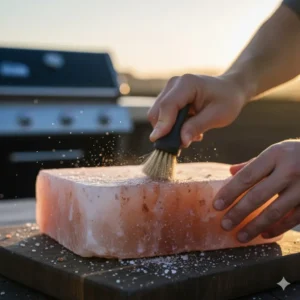
Proper maintenance extends the lifespan of your Himalayan salt block while preserving its natural cooking performance. After preparing burgers or other dishes, always allow the block to cool fully at room temperature—sudden temperature shifts can cause cracks or even structural failure.
Once cool, gently scrape off residue using a plastic or stainless-steel scraper. Avoid submerging the block; a quick wipe or light rinse with warm water effectively removes surface food particles. Never use soap or detergent, as these dissolve the mineral surface and compromise its integrity.
Dry the block with a clean towel, then let it air dry completely before storing it in a cool, low-humidity location. With consistent care and gradual preheating during each use, a high-quality salt block will continue to deliver exceptional searing performance and subtle mineral seasoning for many cooking sessions.
Frequently Asked Questions About Cooking Burgers on a Himalayan Salt Block
Should I season my burger patties with salt before cooking on the salt block?
Additional salt is unnecessary when using a Himalayan salt block. The block naturally infuses the beef with a mild mineral seasoning during searing, creating balanced flavor without excess salinity. A light sprinkle of pepper or a preferred spice mix provides complementary depth.
How can I prevent burgers from sticking to the Himalayan salt block?
When fully preheated to about 450–500°F, the salt block becomes naturally nonstick. Avoid adding oil; instead, pat the patties dry and ensure the surface has reached the correct temperature before placing the meat. A sharp, even sizzle indicates perfect contact for searing.
Can I use the salt block to toast buns or cook other foods?
Yes. The block works well for toasting buns, searing vegetables, or cooking proteins such as shrimp, chicken, and thin steaks. Because each food type absorbs salt differently, brief contact is best for bread to preserve a balanced flavor.
What is the proper way to clean the salt block after cooking greasy burgers?
Allow the block to cool completely before cleaning. Gently scrape away residue with a metal spatula or stainless scrubber, then rinse quickly with warm water—never use soap. Let it air dry fully before storing. This simple routine prevents cracks and extends the block’s lifespan.
How does cooking on a Himalayan salt block compare to using a cast iron pan or grill?
Each method offers distinct results, but salt block cooking provides a unique mineral seasoning and a consistently even crust that traditional grills or pans rarely achieve. The block’s flat, hot, dry surface locks in juices and enhances natural flavor without added salt or oil.
Final Thoughts
Cooking burgers on a Himalayan salt block unlocks flavors and textures traditional grills simply can’t replicate. Its dense, mineral surface distributes heat evenly, forming a uniform caramelized crust while keeping the interior tender and juicy. During searing, the block’s subtle salinity enhances the beef’s flavor naturally, delivering balance without excess salt.
Gradual, controlled heating prevents cracking and preserves the block’s integrity for long-term use. With proper care, it remains a reliable culinary tool that consistently produces restaurant-quality results. Each cooking session refines timing, texture, and flavor precision, building both skill and consistency.
For those ready to expand beyond classic burgers, the same salt block can sear seafood, vegetables, and other proteins with equally refined results—offering versatility that turns everyday cooking into a professional-level experience.


